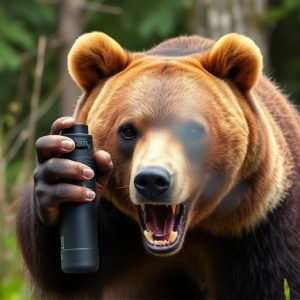Bear Spray Fogger Defense: Ingredients, Expiry & Effective Usage Tips
Bear spray is a vital safety tool in Alaska's wild, but it expires after 2-5 years due to volat…….
Bear spray is a vital safety tool in Alaska's wild, but it expires after 2-5 years due to volatile ingredients like capsaicin. Storage conditions impact longevity; extreme temps, sunlight, or exposure accelerate degradation. Check labels for instructions, replacing bear spray before expiration to ensure maximum protection against bears. Regular maintenance and storage are crucial; protect from damage, corrosion, direct sunlight, heat, and fire. Discard old or expired bear spray as ingredient potency decreases over time.
In Alaska’s vast wilderness, encountering bears is a real possibility. For hikers and outdoor enthusiasts, carrying bear spray is essential. But do you know that your bear spray might have an expiration date? Understanding the ‘Understanding Bear Spray Expire Date’ is crucial for safety. Unpack the ‘Ingredients’ to recognize both active and supporting components. Learn the science behind ‘How Bear Spray Fogger Works’. Discover effective usage tips, safety guidelines, maintenance, and storage methods to ensure your bear spray remains viable when you need it most.
- Understanding Bear Spray Expire Date: What You Need to Know
- Unpacking the Ingredients: Active and Supporting Components
- How Bear Spray Fogger Works: Science Behind the Defense
- Effective Usage and Safety Tips for Optimal Protection
- Maintenance and Storage: Ensuring Your Bear Spray Remains Viable
Understanding Bear Spray Expire Date: What You Need to Know
When considering bear spray as your primary defense while adventuring in Alaska’s wild, understanding its expiration date is paramount. Unlike food or medication, bear spray doesn’t have a specific ‘best before’ label, but it does degrade over time due to the volatile ingredients used, primarily capsaicin and other chemical agents. These components are what make bear spray effective by overwhelming the animal’s senses and temporarily disabling it.
The expiration date usually ranges from 2-5 years, depending on the manufacturer’s recommendations. Factors like storage conditions play a significant role in determining its longevity. Extreme temperatures, direct sunlight, or leaving it exposed can accelerate degradation. Always check the label for specific instructions and ensure you replace your bear spray before its effective period ends to guarantee maximum protection during your outdoor activities in Alaska.
Unpacking the Ingredients: Active and Supporting Components
When it comes to understanding bear spray, one of the key aspects to consider is the ingredients and their effectiveness. Bear spray formulations vary, but a typical product contains a mix of active and supporting components designed to deter aggressive bears. The active ingredient is usually capsicum, derived from chili peppers, which causes a burning sensation in the eyes, nose, and mouth of the target animal. This immediate irritant disrupts a bear’s behavior, giving you valuable time to escape or defend yourself.
Supporting ingredients play a crucial role in enhancing the spray’s performance and longevity. These may include surfactants, which help the capsicum adhere to fur and skin, ensuring maximum impact. Other additives can improve the spray’s range, spread, and stability in varying weather conditions. Understanding these components is essential for choosing bear spray that not only works when needed but also remains effective over its shelf life, as bear spray does expire, typically after 2-3 years, so checking the ingredients list and expiration date is vital before venturing into Alaska’s wilderness.
How Bear Spray Fogger Works: Science Behind the Defense
Bear spray foggers are an effective personal defense mechanism against unpredictable bear encounters in remote outdoor areas, especially in Alaska’s rugged wilderness. The device uses a specialized chemical compound, typically oleoresin capsicum (OC), to create a protective barrier and deter aggressive bears. When activated, the foggers emit a fine mist or cloud of pepper-based spray that can reach up to 30 feet, covering the user in a harsh irritant. This sudden barrage of OC disrupts the bear’s sensory perception, temporarily blinding and disorienting it, giving the user precious time to retreat or defend themselves.
The science behind bear spray fogger defense lies in its ability to target the bear’s eyes, nose, and mouth, which are sensitive areas filled with nerve endings. The OC ingredients, derived from chili peppers, bind to these receptors, causing a strong inflammatory response and intense pain. Unlike traditional spray or bullets, bear spray is non-lethal, providing an opportunity for the user to safely evacuate or use other deterrents if needed. Regular maintenance, including checking expiration dates and ingredient stability, ensures the foggers remain effective, as some components, like OC, can degrade over time, requiring replacement for optimal protection.
Effective Usage and Safety Tips for Optimal Protection
Using bear spray effectively and safely is key for optimal protection in Alaska’s wild environments. When faced with a bear encounter, remember that timing and distance are crucial. Aim for the bear’s face and eyes, creating a large target. The spray should be applied from a safe distance, typically 20-30 feet away, to ensure maximum coverage without putting yourself at risk. Remember, it’s better to use a significant amount to create a dense fog than a weak stream that may not reach the bear effectively.
Safety tips include checking the expiration date of your bear spray regularly, as ingredients and effectiveness can degrade over time. Always store it properly in a cool, dry place, away from direct sunlight. Ensure you familiarize yourself with the specific instructions provided by the manufacturer, especially regarding wind conditions, as these can impact the spray’s range and effectiveness. Practice using the spray before venturing into bear country to build confidence and ensure you’re comfortable with deployment during an actual encounter.
Maintenance and Storage: Ensuring Your Bear Spray Remains Viable
Bear spray foggers are a crucial component of personal safety in Alaska’s wild landscapes, but proper maintenance and storage are essential to ensure their effectiveness. Regular upkeep involves checking the device for any signs of damage or corrosion, especially after harsh winter conditions. It’s important to keep your bear spray out of direct sunlight, extreme heat, or freezing temperatures, as these can compromise the integrity of the canister and affect the viability of the ingredients inside.
Storage should be in a cool, dry place, such as a vehicle’s glovebox or a locked storage compartment. Always store the fogger away from direct contact with fire sources or flammable materials. Additionally, ensure that you replace your bear spray according to the manufacturer’s recommendations, as ingredients can degrade over time. Knowing when to discard old or expired bear spray is vital for your safety, as its effectiveness diminishes, and a stale or weakened solution may not provide adequate protection in an encounter with a bear.
Understanding the expiration date of your bear spray and knowing the active ingredients are key to ensuring effective protection during outdoor adventures in Alaska. With proper usage, safety measures, and storage, you can maximize its viability. Remember, staying informed about the science behind bear spray foggers empowers you to navigate Alaska’s wilderness with confidence and peace of mind.


